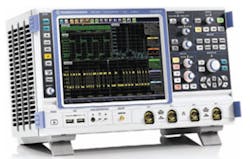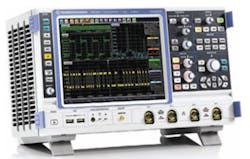At the end of June, R&S announced two scope families—the RTO series with bandwidths of 1 GHz and 2 GHz and the RTM series with a bandwidth of 500 MHz. All models are available in either two- or four-channel versions.
The RTO series has some specifications and user-interface functions worth noting. One of these characteristics is its signal acquisition rate of 1,000,000 waveforms/s. This capability is especially useful for acquiring and analyzing rarely occurring signal faults. At their highest speeds, most scopes acquire signals in only 0.5% of the waveform acquisition cycle and are blind the rest of the time. However, the RTO series blind time is up to 20 times shorter, thereby increasing the acquisition time to 10% of the total cycle. This high rate is maintained for all measurement functions including FFTs and histograms. To achieve this specification, the company developed an ASIC that has 14M gates and performs intensive high-speed parallel processing.
Another innovation in the RTO series is the digital trigger system. Unlike conventional scopes which use analog triggering where the measurement input signal is divided into separate trigger and acquisition paths, the RTO series provides a shared path for the signal and the trigger, which increases trigger sensitivity and decreases trigger jitter. Trigger types accommodated in the scope include edge, glitch, width, runt, window, and time-out. The minimum detectable glitch is 100 ps.
Depending upon user preference, the scope can be operated via the front-panel controls, a mouse, or the touch screen. At the top of the 10.4” LCD is a toolbar with frequently used functions such as undo/redo, zoom, histogram, and trash bin. The menu bar is positioned at the bottom of the screen and visible during touch-screen operation. Waveforms and measurement results are displayed in signal icons on the side of the screen that can be dragged and dropped onto the main screen for full-size viewing. Setup dialog boxes are semitransparent and displayed as overlays on the screen.
Other attributes of the RTO series include a front-end A/D converter with an ENOB of greater than 7 over the entire frequency range, a maximum sampling rate of 10 GS/channel, and a memory depth of up to 80 MS with one channel active. Passive probes are included for each channel of the scope, and optional active probes are available that feature ProbeMeter, an integrated voltmeter that displays the DC value of a signal regardless of other instrument settings.
The other new product introduction, the RTM series, is a general-purpose instrument for everyday test and measurement tasks. The models have a maximum sampling rate of 2.5 GS/s or 5 GS/s interleaved and a memory depth of 4 MS or 8 MS interleaved. Triggering types are many including edge, width, video, pattern, and B-trigger. Sporadic signals can be viewed in any of three modes: Persistence, where many waveforms are superimposed so intermittent signals can be identified; Inverse-brightness, where sporadic events are easier to see; and Temperature color gradient, where the temperature color scale is used to color-code the frequency distribution of display points. A QuickMeas function that is push button activated displays a number of measurement values for an active signal right on the waveform itself. These functions are peak-to-peak voltage, rise time, fall time, mean value, rms value, period, and frequency. A passive probe for each channel is shipped with the instrument.
For More Information
www.rsleads.com/008ee-195

